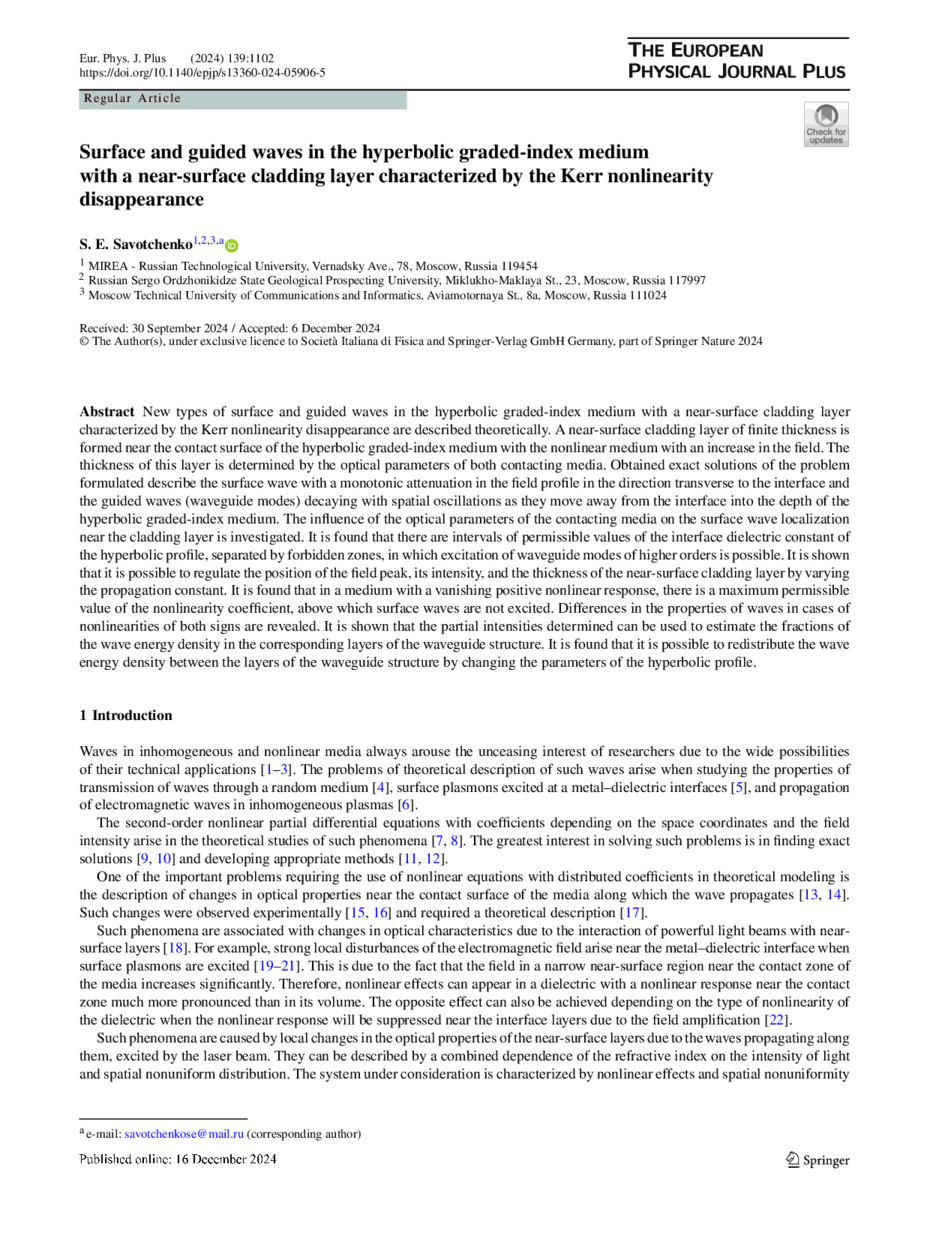https://doi.org/10.1140/epjp/s13360-024-05906-5
Regular Article
Surface and guided waves in the hyperbolic graded-index medium with a near-surface cladding layer characterized by the Kerr nonlinearity disappearance
1
MIREA - Russian Technological University, Vernadsky Ave., 78, 119454, Moscow, Russia
2
Russian Sergo Ordzhonikidze State Geological Prospecting University, Miklukho-Maklaya St., 23, 117997, Moscow, Russia
3
Moscow Technical University of Communications and Informatics, Aviamotornaya St., 8a, 111024, Moscow, Russia
Received:
30
September
2024
Accepted:
6
December
2024
Published online:
16
December
2024
New types of surface and guided waves in the hyperbolic graded-index medium with a near-surface cladding layer characterized by the Kerr nonlinearity disappearance are described theoretically. A near-surface cladding layer of finite thickness is formed near the contact surface of the hyperbolic graded-index medium with the nonlinear medium with an increase in the field. The thickness of this layer is determined by the optical parameters of both contacting media. Obtained exact solutions of the problem formulated describe the surface wave with a monotonic attenuation in the field profile in the direction transverse to the interface and the guided waves (waveguide modes) decaying with spatial oscillations as they move away from the interface into the depth of the hyperbolic graded-index medium. The influence of the optical parameters of the contacting media on the surface wave localization near the cladding layer is investigated. It is found that there are intervals of permissible values of the interface dielectric constant of the hyperbolic profile, separated by forbidden zones, in which excitation of waveguide modes of higher orders is possible. It is shown that it is possible to regulate the position of the field peak, its intensity, and the thickness of the near-surface cladding layer by varying the propagation constant. It is found that in a medium with a vanishing positive nonlinear response, there is a maximum permissible value of the nonlinearity coefficient, above which surface waves are not excited. Differences in the properties of waves in cases of nonlinearities of both signs are revealed. It is shown that the partial intensities determined can be used to estimate the fractions of the wave energy density in the corresponding layers of the waveguide structure. It is found that it is possible to redistribute the wave energy density between the layers of the waveguide structure by changing the parameters of the hyperbolic profile.
Copyright comment Springer Nature or its licensor (e.g. a society or other partner) holds exclusive rights to this article under a publishing agreement with the author(s) or other rightsholder(s); author self-archiving of the accepted manuscript version of this article is solely governed by the terms of such publishing agreement and applicable law.
© The Author(s), under exclusive licence to Società Italiana di Fisica and Springer-Verlag GmbH Germany, part of Springer Nature 2024
Springer Nature or its licensor (e.g. a society or other partner) holds exclusive rights to this article under a publishing agreement with the author(s) or other rightsholder(s); author self-archiving of the accepted manuscript version of this article is solely governed by the terms of such publishing agreement and applicable law.





